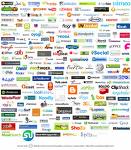
Update: This article has inspired the creation of a new project called Ere I Go. Check out more scenarios of how this technology works. Feel free to contact the team behind it if you have more questions.
It’s easy to spot revolutions or major events in the past. The shrinking of computer parts in the 70s, the PC revolution of the 80s that led to the Internet explosion of the 90s, etc. At the beginning of the new millennium, we had at our fingertips millions of pages of information. It wasn’t a question of ‘is it out there somewhere’, it was a question of ‘it’s out there, how do I find it?’
Enter Google. Google wasn’t the first search engine, nor was it the last, but it quickly became THE search engine because they did something different. Google created a search engine that took all of that information and made it useful and relevant. They did it not by teaching the machine to do it, but instead by teaching the machine to observe what we humans were linking to. By tapping into the social side of information, Google quickly became the best search engine for finding the information in the sea of content.
So the latest ‘big thing’ has been the socializing of the Internet. We now find sites like Digg, reddit, Del.icio.us, etc. that help us wade through all the rough to find the diamond. The buzz word surrounding all of this has been ‘Web 2.0′. This socializing has gone a long way to making sense of it all, but is there more? What is the next big thing?
Realtors have been giving us the answer for years, although they didn’t know it. The next big thing is…’location, location, location’.
Think of how we access all the information of the Internet. We do it at a desk where wires keep us attached to a specific location. Laptops help us branch out a bit, but even then we are tied to a wireless connection. Go too far and you no longer have access to information.
Mobile devices have begun to allow us to take this information with us, but we are still stuck in an old paradigm. If I am standing in the Madrid, Spain train station, there is a good chance I want to ride a train somewhere. But when I connect to the Internet on my mobile device, I’m stuck finding information the old way: through keywords. Somewhere out there is information that would help me, but all I have our my not-as-useful keywords.
The next big thing is to organize, tag, and link information to a specific location. Think of the last time you were at a national park. It’s a very good possibility that the only information you had about the park fit on a tri-fold paper that you picked up at the visitor’s station. In the information age, how is this acceptable?
Instead, imagine visiting the park where hundreds of visitors have linked information to specific locations. You have the architect of the visitor’s center who tells you the history of the building. As you move around the park you access information provided by geologists, geographers, botanists, biologists, environmental scientists, conservationists, hiking enthusiasts, bikers, etc. etc. etc. The information is useful because it’s relevant to the location. And it becomes manageable in the same way that the 10s of millions of pictures on flickr have become manageable, through tagging.
If I’m driving down a dirt road, I can access the Internet, enter in the keywords, “eat, roast beef sandwich’. The next time I pass within 5 miles of an Arby’s, my device let’s me know. Or if I have my mountain bike on the back of my car, I search for the keywords ‘mountain bike trails’. Every time I come within a few miles of a trail, my GPS device alerts me.
We’re beginning to see the first threads of this next big idea. Pictures and Wikipedia articles are now linked to Google Earth. You can access information about a location, but it’s still at your desk. The real revolution will come when this information can be accessed completely and easily from a mobile device, while you’re at that location.
Today we have access to an unfathomable amount of information. Web 2.0 has helped us begin to organize and make sense of that information. Tying information to a location is the next step and will literally open up a whole new world.
Here’s hoping the next iPhone has a built-in GPS.


